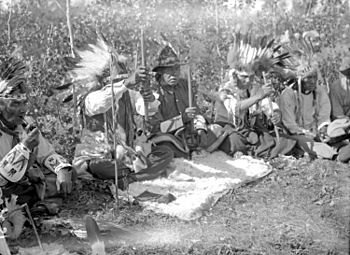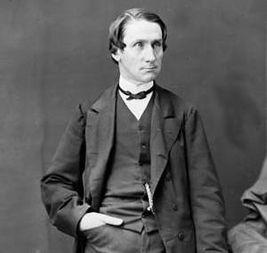Treaty 6 facts for kids
| Treaty No. 6 between Her Majesty the Queen and the Plain and Wood Cree Indians and Other Tribes of Indians at Fort Carlton, Fort Pitt, and Battle River with Adhesions | |
|---|---|
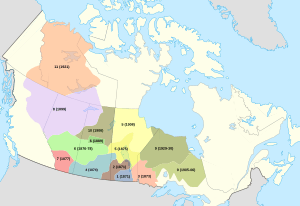
The Numbered Treaties
|
|
| Signed | 23 and 28 August and 9 September 1876 |
| Location | Fort Carlton, Fort Pitt |
| Parties |
|
| Language | English |
Treaty 6 is one of the Numbered Treaties signed in Canada. These treaties were agreements between the Canadian Crown (the government representing the Queen) and different First Nations groups. Treaty 6 was signed between the Crown and the Plains and Woods Cree, Assiniboine, and other band governments. The main signings happened at Fort Carlton and Fort Pitt in 1876.
Important people involved in the talks for the Crown included Alexander Morris, who was the Lieutenant Governor of the North-West Territories. Chiefs Mistawasis and Ahtahkakoop represented the Carlton Cree. This treaty included special terms not found in earlier treaties. These included a medicine chest, help during times of hunger or sickness, more farming tools, and education on reserves. The land covered by Treaty 6 is now most of central Saskatchewan and Alberta.
The first signings took place from August 18 to September 9, 1876. Later, other First Nations groups in the area also signed on, which are called "adhesions." For example, a group in Manitoba signed in 1898. Since it was signed, there have been disagreements about what the treaty terms truly meant. This is because the First Nations and the Crown had different understandings. Treaty 6 is still important today. Edmonton celebrates Treaty 6 Recognition Day every August to remember the signing.
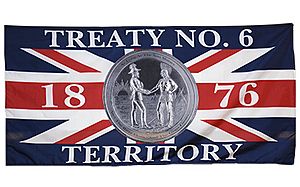
Contents
What is the Confederacy of Treaty Six First Nations?
In 1993, 17 Treaty 6 First Nations in Alberta created the Confederacy of Treaty Six First Nations. This group acts as a united voice for these First Nations. It helps them work together on important issues. This Confederacy only includes First Nations from Alberta.
In 2012, the City of Edmonton signed an agreement with the Confederacy. This was a big step, as it was one of the first agreements like this between a city in Alberta and First Nations governments. Edmonton is located on Treaty 6 land and has many Indigenous people living there. The Confederacy also signed an agreement with the Government of Alberta in 2022. This agreement sets up regular meetings with government leaders to discuss important matters.
Who are the Grand Chiefs of the Confederacy?
The Grand Chief is the main spokesperson for the Confederacy. They represent the member First Nations in public and at political events. Grand Chiefs usually serve for one year and can be chosen again. They are often chiefs of one of the member First Nations.
Some recent Grand Chiefs include:
- 2023: Leonard Standingontheroad (Chief of Montana First Nation)
- 2022: George Arcand Jr. (Chief of Alexander First Nation)
- 2021: Vernon Watchmaker (Chief of Kehewin Cree Nation)
- 2020: William (Billy) Morin (Chief of Enoch Cree Nation)
- 2017, 2018, 2019: Wilton Littlechild (a former Member of Parliament)
- 2015: Bernice Martial (Chief of Cold Lake First Nations, the first woman Grand Chief)
Why was Treaty 6 signed?
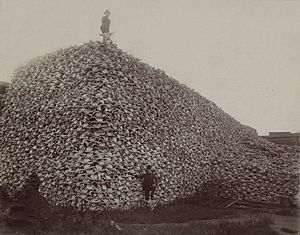
Treaty 6 was signed in August 1876 between the Canadian Crown and the Plains and Woods Cree, Assiniboine, and other groups. Key people involved were Alexander Morris and James McKay. Chiefs Mistawasis and Ahtahkakoop represented the Carlton Cree.
Before the late 1800s, bison (buffalo) hunting was a way of life for the Plains Indians. Bison provided food, clothing, and shelter. But by the 1870s, the number of bison had dropped greatly. This made First Nations leaders worried about their people starving. They believed a treaty with the government would help them get food and support.
Another reason for signing the treaty was the fear of smallpox. This disease had spread to northern plains First Nations between 1870 and 1874. Many Cree people died because they had no protection against it. The chiefs hoped a treaty would offer help with diseases.
First Nations were also concerned about their land being taken over by settlers and surveyors. They worried when the North-West Territories were sold to Canada from the Hudson's Bay Company. For years, the government didn't seem interested in a treaty. But when the Cree stopped surveyors and telegraph workers, the government paid attention. They didn't want a war and wanted settlement to continue. This led to the start of the Treaty 6 talks at Fort Carlton.
What were the terms of Treaty 6?
The government used earlier agreements, called the Robinson Treaties, as a guide for Treaty 6. In those treaties, First Nations received money and yearly payments. They also got reserves (protected land) and the right to hunt and fish on their traditional lands. However, the First Nations involved in Treaty 6 asked for and got extra terms that the government hadn't planned to include.
The written terms of the treaty state that First Nations gave up their rights to the land to the Canadian government forever. However, First Nations have a different understanding based on their oral histories and traditions. In their languages, there might not be words for "land ownership" or "give up." This has caused disagreements about what was truly agreed upon.
During the talks, First Nations asked for many things. These included farming tools, animals like oxen and cows for each family, and help for those who couldn't work. They also asked for a ban on alcohol in Saskatchewan and for education on each reserve. Other requests included being able to choose their settlement location, taking resources like timber from Crown lands, cooking stoves, medicine, and access to bridges.
In return for the land, the government agreed to set aside "reserves" for First Nations. These lands were protected from settlers. The government also promised to open schools for Indigenous children on reserves. The idea was to help them communicate with settlers and learn European ways of living. At first, education was optional. But later, Indigenous children were forced to attend schools, even though the treaty said it was their choice. The sale of alcohol was also limited on reserves.
The terms of Treaty 6 gave each family of five one square mile of land. Smaller families received land based on their size. Each person received $12 right away and an extra $5 each year. Chiefs and other leaders received more money and supplies like horses and wagons. First Nations also received a yearly grant for ammunition and twine for fishing nets. They were also given many farming tools, seeds, and animals like oxen, cows, and pigs. These tools and animals were meant to help First Nations create a living for themselves.
What is the Pipe Ceremony?
Religious practices are very important to Indigenous people. The pipe ceremony is a sacred event. It shows honor and pride and is done to make sure both sides of an agreement keep their word. It is believed that only the truth should be spoken when the pipe is present.
The pipe ceremony was part of the Treaty 6 negotiations. It symbolized that the treaty would be honored forever by both First Nations and the Crown. It also meant that everything said during the talks would be respected. The ceremony began with Lieutenant Governor Alexander Morris touching the pipe. This showed that the Crown accepted the friendship of the First Nations, starting the talks. It's also how Indigenous people show an agreement is complete and that words are guaranteed.
However, the Crown's negotiators did not see the ceremony as important as the First Nations did. They didn't realize how sacred it was. This meant that spoken agreements had much more meaning to First Nations than to the Crown. For Indigenous peoples, spoken agreements are just as important as written ones.
Why was there miscommunication?
The Government of Canada believes the treaty terms were clearly written. But First Nations, through their oral traditions, have a different understanding. Even with three interpreters present (two from the Crown, one from First Nations), direct translation between English and Cree was difficult. Some words or ideas in one language didn't have an exact match in the other. This meant that both groups didn't fully understand each other.
First Nations had to rely on their interpreter because the treaty document was only in English. They claim they agreed to Treaty 6 because they were told the Crown wanted to "borrow" their land, not buy it. Another understanding was that First Nations could choose how much land they wanted. But then surveyors came and set specific boundaries, which was seen as breaking the treaty.
First Nations also thought the treaty would change over time to fit new conditions. For example, they expected changes in money value, health services, and farming tools. However, the treaty terms have mostly stayed the same. This has led First Nations to believe the treaty should be updated to meet their needs today.
Alexander Morris told First Nations that the Queen wanted peace and for all her "children" to be happy. This statement was important to First Nations because women often have a very important role in their culture. They believed the Queen, as a woman, was sharing the land, not taking it away. The phrase "for as long as the sun shines and the waters flow" was used to promise the treaty would last forever. The Crown thought "waters" meant rivers and lakes. But First Nations understood it to mean as long as children were being born, the treaty would continue.
What is the Medicine Chest Clause?
One important part of Treaty 6 was the "medicine chest clause." This meant that a medicine chest would be kept at the Indian agent's home for First Nations people to use. Another promise was help during times of hunger or sickness.
First Nations leaders understand the "medicine chest clause" to mean that the government must provide all kinds of healthcare to First Nations people forever. Groups like the Assembly of First Nations see government funding for health programs as part of this responsibility.
Historian John Taylor said: "At the time Treaty 6 was signed, the famous medicine chest clause was inserted at Indian insistence that the Indian agent should keep a medicine chest at his house for use. Today Indian thinking is this means medical care, in general terms, the medicine chest may be all they had at that time and place but today we have a broader range of medical care and this is a symbol for that."
Perry Bellegarde, a former Grand Chief, explained: "The interpretation of that clause is very different for the federal government employees or bureaucrats and the Indian leadership because to us and to our elders and leaders who negotiated and signed that treaty, it refers to health care and health benefits for our people. And because our traditional way of healing is still present and alive but we recognized that we would need that assistance."
List of Treaty 6 First Nations
- Alberta
- Alexander First Nation
- Alexis First Nation
- Beaver Lake Cree Nation
- Cold Lake First Nation
- Enoch Cree Nation
- Ermineskin Cree Nation
- Frog Lake First Nation
- Heart Lake First Nation
- Kehewin Cree Nation
- Louis Bull Tribe
- Michel First Nation
- Montana First Nation
- O'Chiese First Nation
- Papaschase
- Paul First Nation
- Saddle Lake Cree Nation
- Samson First Nation
- Sunchild First Nation
- Manitoba
- Saskatchewan
- Ahtahkakoop First Nation
- Beardy's and Okemasis First Nation
- Big Island Lake Cree Nation
- Big River First Nation
- Flying Dust First Nation
- James Smith First Nation
- Lac La Ronge First Nation
- Little Pine First Nation
- Lucky Man First Nation
- Makwa Sahgaiehcan First Nation
- Ministikwan Lake Cree Nation
- Mistawasis First Nation
- Montreal Lake Cree Nation
- Moosomin First Nation
- Mosquito-Grizzly Bear's Head-Lean Man
- Muskeg Lake Cree Nation
- Muskoday First Nation
- One Arrow First Nation
- Onion Lake Cree Nation
- Pelican Lake First Nation
- Peter Ballantyne Cree Nation
- Poundmaker Cree Nation
- Red Pheasant First Nation
- Saulteaux First Nation
- Sweetgrass First Nation
- Sturgeon Lake First Nation
- Thunderchild First Nation
- Waterhen Lake First Nation
- Witchekan Lake First Nation
Timeline of Treaty 6 Signings
| Date | Event |
|---|---|
| 23 August 1876 | First signing at Fort Carlton |
| 28 August 1876 | Second signing at Fort Carlton |
| 9 September 1876 | Fort Pitt signing |
| 9 August 1877 | Fort Pitt adhesion signing by Cree groups |
| 21 August 1877 | Fort Edmonton signing |
| 25 September 1877 | Blackfoot Crossing signing (at Siksika Nation reserve, Alberta) |
| 19 August 1878 | Additional signing |
| 29 August 1878 | Battleford signing |
| 3 September 1878 | Carlton signing |
| 18 September 1878 | Additional signing, Michel Calihoo Band near Edmonton, Alberta |
| 2 July 1879 | Fort Walsh signing |
| 8 December 1882 | Further Fort Walsh signing |
| 11 February 1889 | Montreal Lake signing |
| 10 August 1898 | Colomb band signing in Manitoba |
| 25 May 1944 | Rocky Mountain House adhesion signing |
| 13 May 1950 | Further Rocky Mountain House adhesion signing |
| 21 November 1950 | Witchekan Lake signing |
| 18 August 1954 | Cochin signing |
| 15 May 1956 | Further Cochin signing |
| 1958 | Most members of the Michel Band lost their Treaty status and became Canadian citizens. Their reserve was dissolved. |
See also



